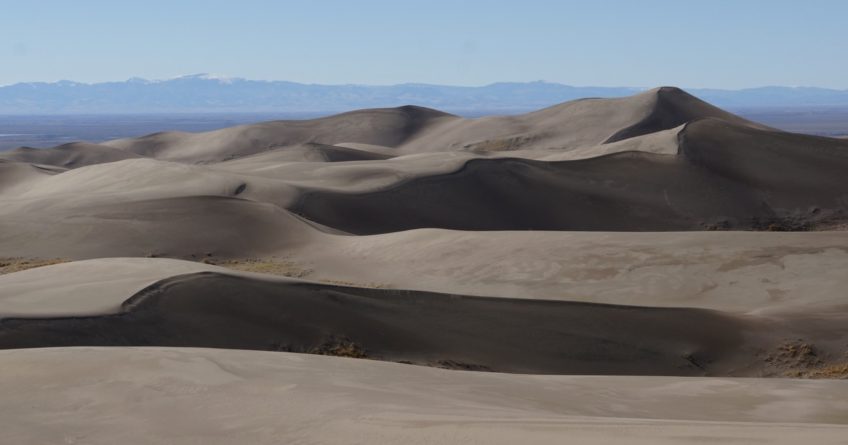My uncharacteristic late-night exodus from New Mexico had landed me in Alamosa, the gateway to Great Sands National Park. My first day there, however, was frought with icy precipitation and high-speed winds. Not wanting to explore the dunes in freezing rain, I took a day to orient myself in the town and finish up some latent tasks that had been piling up. I found a great non-profit coffee shop called Milagros that had speedy wifi and a delicious dark roast. There, I passed my first day preparing for the next day’s activities and praying for sunny weather. As the clouds broke in late afternoon, I drove out to the dunes just as the visitor’s center was closing up shop. With the dunes rising in front of me, I fantasized about the possibilities that lay ahead.



The next day, as the goblins and ghouls mustered for their sugar-fueled assault on All Hallows’ Eve, I made my way into the dunes. Piled at the foot of the formidable Sangre De Cristo Mountain Range, the towering dunes of Great Sand Dunes National Park and Reserve rise unexpectedly from the surrounding plains. Formed by the interplay between glacial sedimentary deposits, wind patterns, ongoing erosion, and a system of braided streams (mainly the wandering, seasonal Medano Creek), the dunes themselves change constantly and are actually slowly growing. Some of them stand well over 700 feet tall, making them the tallest in North America (and a formidable adversary for hikers and dune enthusiasts alike). Even in the chilly weather of the shoulder season, I could see sandboards carving down the dunes and playful people of all age ragdolling down the steep slopes. There couldn’t, however, have been more than a few dozen people there that Halloween afternoon.


I kicked off my day at the park relatively early. Having seen the dunes from afar the day before, I was itching to go exploring. Upon checking in at the visitor’s center, a ranger informed me that I could camp out on the dunes… for free. Naturally, I secured a backcountry camping permit immediately. Since there aren’t necessarily specific sites that Great Sand Dunes National Park is known for, wandering is the main objective of most hikers. In search of the perfect spot, I marched up crests that led into curving ridges. I glided down valleys and climbed onto domes. At each point, the never-ending dunescape spread towards the horizon, ending abruptly in the sheer faces of the mountains. I felt like I was in a giant sandbox of confused waves formed by opposing winds.


I spent my first few hours distancing myself from the day-use visitors. After finding a relatively flat, secluded, but gorgeous campsite, I set up my tent. Here, I ran into my first problem. My tent, a Hilleberg Anjan 2, is a tension tent. Normally, the surfaces I am camping on hold tent stakes firmly, allowing me to tighten my tent to my heart’s content. The loose sand of the dunes proved a formidable opponent on this front. Yet, after setting up multiple guy lines and using all of my spare stakes, my tent seemed ready to handle a calm night on the dunes. I crossed my fingers that the winds would not pick up throughout the day. Satisfied with my handiwork for the time being, I left my gear behind and spent the rest of the day frolicking among the dunes, reading a book on American definitions of wilderness, and photographing the ever growing shadows spreading over the sand. As the afternoon transitioned into dusk, golden light and deep shadows spread over the dunes like wildfire. The dunes represented an entirely different kind of “wild” that I had never experienced before.


With temperatures expected to drop below 30°, I bundled up and prepared for a chilly night. As the sun was setting, I had noticed, however, that the winds had been building. Kicking myself, I realized that wind would obviously be a factor that night. Wind shapes these dunes. Here I was hoping that it would be a calm night so that my tent might hold its shape. As I lay there, the winds continued to build…

By 8:00 PM, I realized that either I was going to pack up now and call it quits or pack up later after my tent had collapsed around me and the temperatures were below freezing. Choosing the former option, I quickly broke down camp in the uninterrupted darkness and imposing silence of the dunes. With my pack ready and all my gear stowed, I turned off my headlamp. As soon as I did, stars began to glow across the heavens with satellites and the blinking lights of commercial airliners dancing among them. With the moon still hidden by the mountains, I stared up at a truly dark sky. The Milky Way stretched from horizon to horizon like a ribbon of smoke, twinkling gently, crisscrossed intermittently by shooting stars.
In the darkness, I lined up an unknown star with Blanca Peak, the landmark I used to navigate back to my car and took a compass bearing. The rising moon backlit the mountains, making their outline perceptible against the dark horizon. Walking in sand dunes in utter darkness, however, is a truly disconcerting experience. Using my star low on the horizon, I made sure that my bearing remained constant. My path, however, traversed slopes, avoided summits, snaked along ridges, never following a direct path. Far from straight, my path was far more serpentine and inefficient. Two hours later, the lights of the NPS outbuildings appeared on the shifting horizon. Although I had known that I was going the right direction, the lights were a welcome reminder that my relatively blind trajectory would end at my vehicle.
Finally, I hit the pavement and headed towards my car. Over the course of the past two hours, the winds that had worried me had died and the night was completely calm. My gamble might have been premature, but the alternative would not have been fun. My late-night stroll through the dunes, however, had turned into a total highlight. Few people can say that they have slept on the dunes (which I had for at least a few hours) and fewer still can speak to the nighttime wonders of solitude in such a foreign landscape under the light of thousands of stars. It was beautiful, surreal, and humbling.
Not wanting to sleep illegally in the Park, I headed for a Bureau of Land Management campground just beneath Zapata Falls, setting myself up perfectly for a hike up to South Zapata Lake. Despite the falling temperatures, that turned out to be one of my coziest and uninterrupted nights of sleep thus far.



2 Responses
Mom
Wonderful photos, Jeremy. You’ve really captured both the vastness and the beauty of these areas, with the help of the hikers and your tent for scale 🙂
Jean Cronon
I would have made the same choice you did to break camp and head for “Home”. “Better to be safe than sorry”. Lucky too that you carry good guiding equipment.